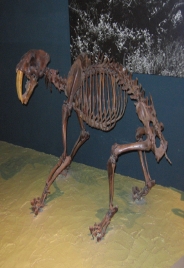Smilodon is an extinct species of saber-toothed cats which lived from 10,000 to 3 million years ago in North and South America. Their name means “knife tooth,” and this is an excellent name given their large fangs, which were as long as 7 inches in length. Paleontologists today know more about this cat than other prehistoric species, because many have been found in the La Brea Tarpits in Los Angeles.
A full grown Smilodon was about the same size as a modern lion, and weighed about 450 pounds. It had a short tail, a large head, and powerful legs which were short. The Smilodon was known for its brutal strength. Its jaws could open at an angle of over 60 degrees. Smilodons are related to the Machairodontinae family of felines.
 The term “saber toothed tigers” is quite misleading, because there is no evidence that Smilodons or any other Machairodonts were related to tigers at all. In fact, there is no evidence that the Smilodon hunted like modern tigers. A DNA analysis conducted in 2005 shows that the Smilodon separated from the earliest ancestors of cats and are not related to any modern species of felines.
The term “saber toothed tigers” is quite misleading, because there is no evidence that Smilodons or any other Machairodonts were related to tigers at all. In fact, there is no evidence that the Smilodon hunted like modern tigers. A DNA analysis conducted in 2005 shows that the Smilodon separated from the earliest ancestors of cats and are not related to any modern species of felines.
Many also believe that the Smilodon lived primarily in cold areas because of the ice age. While this is true for some species, Smilodons would have also lived in warmer climates as well. They are not true “dinosaurs” and became extinct millions of years after the Cretaceous Tertirary Event 65 million years ago. Smilodons became extinct in the last 10,000 years.
The method by which Smilodons hunted is strongly debated among paleontologists. At one time it was believed that they attacked prey by opening their jaws and using their large teeth to stab their victims. Today this is debated, because the long teeth would have been fragile. Any large animal stuggling with them could damage their teeth. Many believed the Smilodon focused on slicing open the windpipe of the victim, or worked in packs to subdue the prey before delivering a fatal bite. This is much less risky than stabbing the prey.
